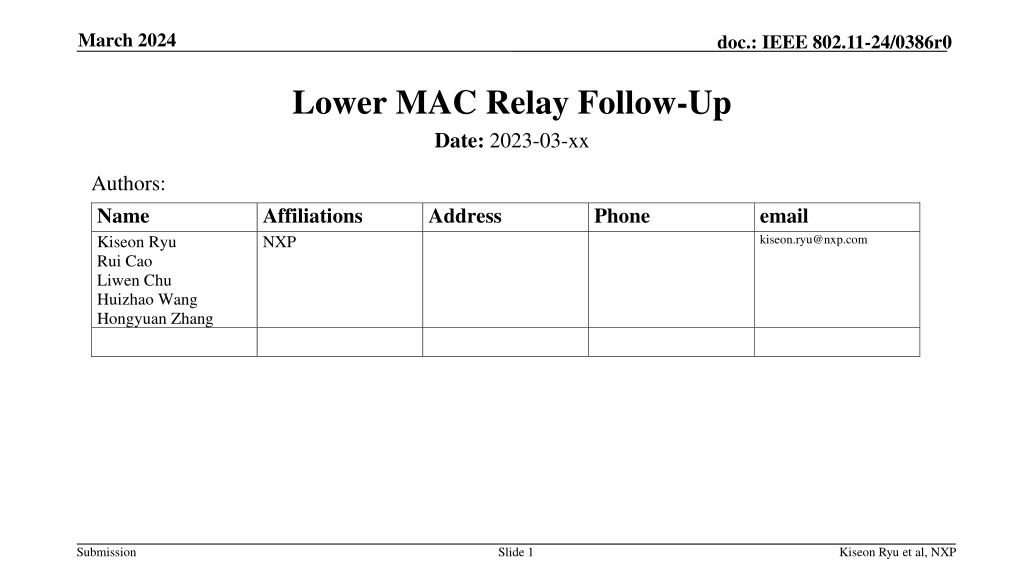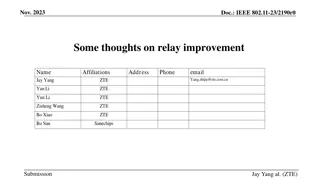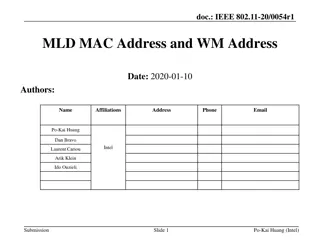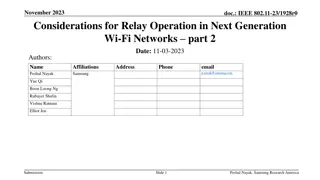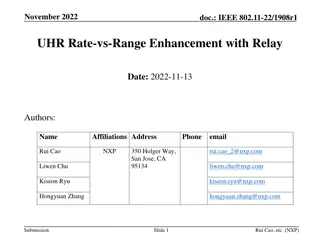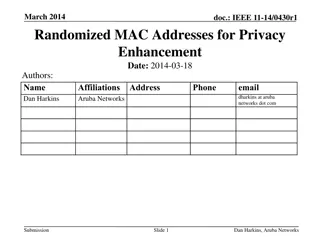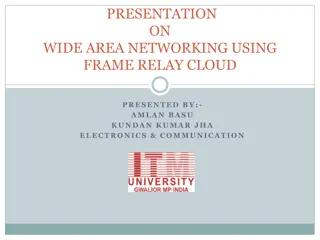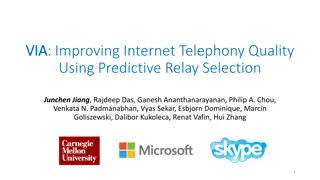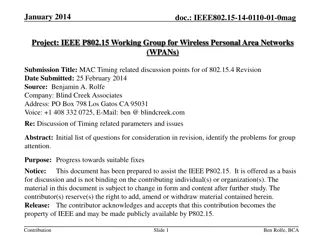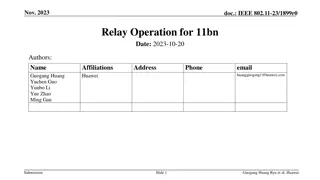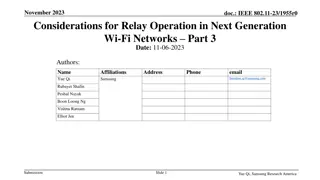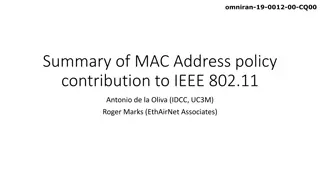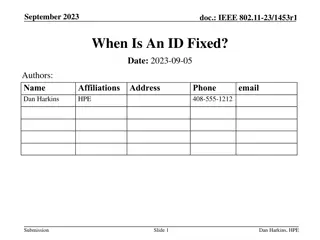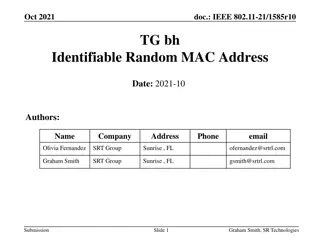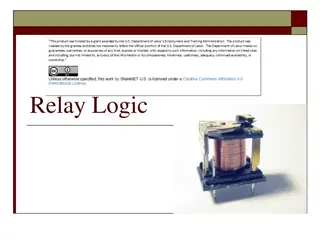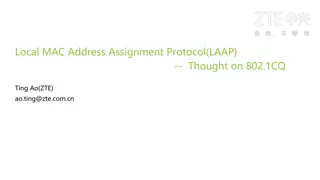IEEE 802.11-24/0386r0 Lower MAC Relay Protocol Details
Detailed discussion on supporting the relay protocol in IEEE 802.11bn, covering relay addressing, end-to-end BA, relay TXOP protection, beacon forwarding, security processing, non-UHR STA support, sounding procedure, A-MPDU aggregation, de-aggregation, and more. The relay operation involves relay devices with only PHY and lower MAC functions, facilitating frame transmission between end devices efficiently.
Download Presentation

Please find below an Image/Link to download the presentation.
The content on the website is provided AS IS for your information and personal use only. It may not be sold, licensed, or shared on other websites without obtaining consent from the author. Download presentation by click this link. If you encounter any issues during the download, it is possible that the publisher has removed the file from their server.
E N D
Presentation Transcript
March 2024 doc.: IEEE 802.11-24/0386r0 Lower MAC Relay Follow-Up Date: 2023-03-xx Authors: Name Kiseon Ryu Rui Cao Liwen Chu Huizhao Wang Hongyuan Zhang Affiliations NXP Address Phone email kiseon.ryu@nxp.com Submission Slide 1 Kiseon Ryu et al, NXP
March 2024 doc.: IEEE 802.11-24/0386r0 Introduction (U) (C) (U) (C) In [1], we introduced a high-level concept of relay protocol with the low complexity and a simple solution for UHR. A relay device has only PHY and lower MAC functions (e.g., (A-)MPDU processing, hop-by-hop BA processing, etc.) without upper MAC functions (e.g., security processing, SN processing, etc.). End devices (i.e., a non-AP STA and an AP) involve both lower MAC and upper MAC functions when transmitting/receiving frames through the relay device. Relay operation can be done in a single TXOP by TXOP sharing. IEEE 802.1X IEEE 802.1X Controlled and Uncontrolled Port Filtering (optional) (M) Controlled and Uncontrolled Port Filtering (optional) (M) RX/TX MSDU Rate Limiting RX/TX MSDU Rate Limiting A-MSDU MSDU Flow - Transmitting A-MSDU MSDU Flow - Transmitting MSDU Flow Receiving MSDU Flow Receiving Aggregation (TX) / De-aggregation (RX) Aggregation (TX) / De-aggregation (RX) Replay Detection Per PN (optional) Replay Detection Per PN (optional) PS Defer Queuing1 (AP MLD Only) PS Defer Queuing1 (AP MLD Only) Upper MAC sublayer: tSTA/dSTA only functions Block Ack Buffering and Reordering per SN Block Ack Buffering and Reordering per SN Sequence Number Assignment Sequence Number Assignment MPDU Decryption MPDU Decryption Packet Number Assignment Packet Number Assignment Duplicate Detection per SN Duplicate Detection per SN E2E Block Ack Scoreboarding E2E Block Ack Scoreboarding MPDU Encryption MPDU Encryption Null Null Null Null Relay Block Ack Scoreboarding Relay Block Ack Scoreboarding Null MPDU Header + CRC Creation MPDU Header + CRC Creation MPDU Header + CRC Creation Address 1 address filtering Address 1 address filtering Address 1 address filtering lower MAC sublayer: Relay functions MPDU Header + CRC Validation MPDU Header + CRC Validation MPDU Header + CRC Validation In this document, we discuss further details to support the relay protocol in 11bn such as relay addressing, end-to-end BA, relay TXOP protection, Beacon forwarding, security processing, non-UHR STA support, sounding procedure, etc. A-MPDU Aggregation A-MPDU Aggregation A-MPDU Aggregation A-MPDU De-aggregation A-MPDU De-aggregation A-MPDU De-aggregation (PHY SAP) (PHY SAP) (PHY SAP) PHY of tSTA PHY of dSTA PHY of rSTA dSTA tSTA rSTA Submission Slide 2 Kiseon Ryu et al, NXP
March 2024 doc.: IEEE 802.11-24/0386r0 Recap) Lower MAC Relay [1] Non-AP STA Relay AP A relay device decodes and forwards (A-)MPDU, that is successfully received from a source device, to a destination device within a TXOP (a.k.a relay TXOP). For DL relay, the source device and the destination device are an AP and a non-AP STA respectively, and vice-versa for UL relay. The relay device can empty the Rx/Tx buffer after the relay TXOP. In a separate TXOP, the source device may retransmit any failed MPDU to the destination device through the relay device, based on the end- to-end BA frame forwarded by the relay device. TXOP Protection 1st hop frame 1st hop BA/Ack 2nd hop frame 2nd hop BA/Ack E2E BA/Ack Example of DL relay Submission Slide 3 Kiseon Ryu et al, NXP
March 2024 doc.: IEEE 802.11-24/0386r0 Addressing in Data/Management frames for relay For relay operation, at least three address information should be indicated in a relayed frame such as the RA, the TA, and the SA/DA. 1st hop frame should indicate the RA (e.g., relay device), the TA (e.g., AP for DL, non-AP STA for UL) and the DA (e.g., non-AP STA for DL, AP for UL). 2nd hop frame should indicate the RA (e.g., non-AP STA for DL, AP for UL), the TA (e.g., relay device) and the SA (e.g., AP for DL, non-AP STA for UL). AP DL UL RA: Relay TA: AP A-Control: STA's AID (DA) RA: AP TA: Relay A-Control: STA's AID (SA) Proposal Relay device can store the mapping table for the STA's AID and MAC address A relay device stores the non-AP STA s address information (e.g., mapping of the AID and the MAC address) that can be relayed. Additional address information (i.e., SA/DA) can be indicated in the A-Control field. The AID of the non-AP STA (as in the source address or the destination address) can be included in the MAC header of the 1st hop and/or the 2nd hop frame. Additional address information for the AP (i.e., the SA for DL, and the DA for UL) may not be included in the relayed frame. The relay device can update the RA/TA fields and the additional address (SA/DA) in the A- Control field when relaying the frame, based on the additional address information indicated in the A-Control field of the received frame and the stored non-AP STA s AID/MAC address mapping information. Relay DL UL RA: STA TA: Relay RA: Relay TA: STA STA Example of addressing in a Data/Management frame for relay Submission Slide 4 Kiseon Ryu et al, NXP
March 2024 doc.: IEEE 802.11-24/0386r0 Addressing in Data/Management frames for relay Relay A-Control field can be included in the relayed frame with the following information. The Hop subfield: 0: 1st Hop Tx 1: 2nd Hop Tx The Direction subfield: 0: Downlink 1: Uplink The AID subfield: If the Hop subfield is set to 0 and the Direction subfield is set to 0, the AID subfield is set to a non-AP STA s AID that is a destination device. If the Hop subfield is set to 1 and the Direction subfield is set to 1, the AID subfield is set to a non-AP STA s AID that is a source device. Relay A-Control field format Hop Direction AID Bits: 1 1 11 Example of Relay A-Control field Note: The Hop subfield and the Direction subfield can be replaced with 1 bit indication indicating the AID for a non-AP STA that is for either a source device or a destination device depending on the direction of the relay operation. Submission Slide 5 Kiseon Ryu et al, NXP
March 2024 doc.: IEEE 802.11-24/0386r0 Addressing in relayed BA frames Relayed BA frame (e.g., 2nd hop BA or E2E BA) should be able to indicate an additional address information (i.e., source address or destination address) in addition to the RA/TA fields. Multi-STA BA can be used as a relayed BA frame (e.g., E2E BA for DL relay, and 2nd hop BA frame for UL relay) that includes additional address information (e.g., SA and DA) in the Per AID TID info field. Non-AP STA Relay AP Non-AP STA Relay AP TXOP Protection (for UL relay) TXOP Protection (for DL relay) 1st hop frame 1st hop frame 1st hop BA 1st hop BA 2nd hop frame 2nd hop frame 2nd hop BA 2nd hop BA (RA: Relay MAC address TA: AP MAC address DA: Non-AP STA AID or MAC address) (RA: Relay MAC Address TA: Non-AP STA MAC Address) *E2E BA (for UHR STA) (RA: Non-AP STA MAC address TA: Relay MAC address) E2E BA (RA: AP MAC ADDRESS TA: RELAY MAC ADDRESS SA: NON-AP STA AID OR MAC ADDRESS) *E2E BA/Ack is not present for a non-UHR STA Example of DL relay Example of UL relay Submission Slide 6 Kiseon Ryu et al, NXP
March 2024 doc.: IEEE 802.11-24/0386r0 Relay TXOP protection The existing RTS/CTS may not work for relay transmission since three devices with two hops are involved for relay operation. E.g., 2nd hop transmission may not be protected through the RTS/CTS frame exchanges between the AP and the relay device for the DL relay case. 1st hop frame RTSA Proposal AP MAC control frame exchanges among an AP, a relay device and a non-AP STA can be performed to protect the relay TXOP. E.g. , For DL relay TXOP protection, Step 1: AP transmits a RTS Announcement frame that triggers RTS frame transmission from the relay device. Step 2: Relay device transmits an RTS frame to the non-AP STA in response to the RTS Announcement frame. Step 3: Non-AP STA responds with a CTS frame in response to the RTS frame. Step 4: Relay device transmit another CTS frame for confirmation purpose. Step 5: If the AP receive the CTS frame from the relay device, the AP initiates frame exchanges with the non-AP STA through the relay device. Note 1. For UL relay TXOP protection, a UHR STA can initiate a TXOP by transmitting an RTSA frame to a relay device. Note 2. For UL relay from a non-UHR STA, the relay TXOP protection described above might not be supported. Instead, the existing RTS/CTS frame exchanges between the non-UHR STA and the relay device can be done. The full protection of the relay TXOP might not be provided. 2nd hop frame E2E BA 1st BA RTS CTS Relay 2nd BA CTS STA 3rd party STA NAV NAV NAV Example of relay TXOP protection for DL Submission Slide 7 Kiseon Ryu et al, NXP
March 2024 doc.: IEEE 802.11-24/0386r0 Beacon forwarding by the relay device For a non-AP STA to discover a relay device and to measure the channel quality for selection of the relay device, the relay device can forward a Beacon frame received from an AP that it can perform relay operation with. An AP may announce to non-AP STAs that a relay device forwards a Beacon frame within its BSS. The contents of the forwarded Beacon frame can be the same as the received Beacon frame with the following exceptions. The TSF value can be updated based on the calculation of the Beacon forwarding time. The TA field can be changed to a MAC address of the relay device. Other exception is TBD. A relay device can transmit a forwarded Beacon frame SIFS after a Beacon frame received from an AP or through the backoff procedure. In addition, for non-AP STA s association through a relay device, the relay device may forward an individually addressed management frame (e.g., Probe Request/Response, Authentication Request/Response, Association Request/Response, etc.) received from an unassociated non-AP STA to an AP for UL, and vice-versa for DL. How to indicate the additional address information (e.g., SA/DA of the non-AP STA) in the management frame is TBD. Submission Slide 8 Kiseon Ryu et al, NXP
March 2024 doc.: IEEE 802.11-24/0386r0 Security processing for relay As similar to seamless roaming architecture (e.g., AP MLD and Roaming AP MLD), an AP and a relay device can share the same AP MLD MAC address so that the end devices (i.e., the AP and an associated non-AP STA) can generate security keys, based on [AP MLD MAC address, Non-AP MLD MAC address] for encryption and integrity protection for the frame to be relayed. All the security processing can be performed by the end devices, and the relay device does not involve in the security processing. Security key update may not be needed when the communication link is changed between the direct link (i.e., AP to STA) and the relay link (i.e., AP to Relay to STA) for a UHR STA. Note 1: When a non-UHR STA is associated with an AP through a relay device, the security keys can be generated based on [Relay MAC address, STA MAC address] by the AP and the non-AP STA for security processing. A non-UHR EHT STA is TBD. Note 2: When relaying the frame, MAC header protection and MAC control frame protection can be disabled. Submission Slide 9 Kiseon Ryu et al, NXP
March 2024 doc.: IEEE 802.11-24/0386r0 Non-UHR STA Support A non-UHR STA does not support E2E BA (e.g., for UL relay in slide 6) Relay TXOP protection (e.g., RTSA Tx as a TXOP holder in slide 7) Announcement info of the relay device in a Beacon/Probe Response frame sent by an AP Note. The non-UHR STA can act as being associated with the relay device not with the AP. For UL relay with a non-UHR STA, a relay device may extend a TXOP by modifying the Duration field in a frame (e.g., CTS frame and/or the last BA frame), or triggered TXOP sharing can be used. See the below figures. The relay device may retransmit a failed (A-)MPDU based on a 2nd hop BA frame for the extended TXOP or for the allocated time duration in the same TXOP. Non-AP STA Relay AP Non-AP STA Relay AP RTS MU-RTS TXS Trigger Duration SIFS CTS (optionally w/ modified Duration extending the TXOP) CTS (MU-RTS TXS or Basic) Trigger SIFS Duration A-MPDU CTS SIFS BA (w/ modified Duration extending the TXOP) A-MPDU in a Non-TB PPDU, or a TB PPDU xIFS Duration A-MPDU BA SIFS A-MPDU BA BA Example of EDCA-based UL relay for a non-UHR STA Example of trigger-based UL relay for a non-UHR STA Submission Slide 10 Kiseon Ryu et al, NXP
March 2024 doc.: IEEE 802.11-24/0386r0 Sounding procedure for relay Channel measurement and link adaptation for 1st hop and 2nd hop links can be done independently. Sounding Procedure in a shared/extended TXOP To minimize the channel access from the rely device, a cascaded sounding procedure can be considered. Cascaded sounding sequence for both 1st hop link and 2nd hop link can be done sequentially within a single shared/extended TXOP. An AP or a non-AP STA may initiate a cascaded sounding procedure. The AP or the non-AP STA as a sounding initiator may indicate the cascaded sounding in an NDPA frame. The NDPA received from a source device can include an explicit indication and/or a destination device s address information (e.g., MAC address or AID). With a result of sounding for each link (1st and 2nd hop links), beamforming transmission can be done independently with a different set of SM matrixes for each link. BFer/BFee between an AP and a relay device with a first set of SM matrixes. BFer/BFee between a relay device and a non-AP STA with a second set of SM matrixes Non-AP STA Relay AP 1st NDP Announcement 1st Sounding NDP 1st Compressed Beamforming/CQI 2nd NDP Announcement 2nd Sounding NDP 2nd Compressed Beamforming/CQI Example of cascaded sounding sequence Submission Slide 11 Kiseon Ryu et al, NXP
March 2024 doc.: IEEE 802.11-24/0386r0 Summary In this contribution, we discuss further details about low complexity relay protocol for UHR with the following features. Relay addressing End-to-end BA Relay TXOP protection Beacon forwarding Security processing for relay Non-UHR STA support Sounding procedure for relay We suggest to define a relay protocol in 802.11bn to improve RvR (Rate-vs-Range) with simple relay processing. Submission Slide 12 Kiseon Ryu et al, NXP
March 2024 doc.: IEEE 802.11-24/0386r0 Straw Poll 1 Do you support to define a relay protocol in 11bn to improve RvR (Rate-vs- Range) requirement? Y/N/A: Submission Slide 13 Kiseon Ryu et al, NXP
March 2024 doc.: IEEE 802.11-24/0386r0 Straw Poll 2 Do you support a relay protocol in 11bn with the followings? A relay device performs only PHY and lower MAC functions (e.g., (A-)MPDU processing, hop-by-hop BA processing, etc.) without upper MAC function (e.g., security processing, SN processing, etc.). End devices (i.e., a non-AP STA and an AP) performs both lower MAC and upper MAC functions as well as PHY function when transmitting/receiving frames through the relay device. Y/N/A: Submission Slide 14 Kiseon Ryu et al, NXP
March 2024 doc.: IEEE 802.11-24/0386r0 Straw Poll 3 Do you agree to the following principles for UHR relay in 11bn? No multi-hop relay support Only one relay device can relay frame(s) between a source device and a destination device within a TXOP. Relay operation within a TXOP The TXOP can be shared with a relay device by a TXOP holder. The relay device can empty the Rx/Tx buffer and discard the BA scoreboard after the TXOP. Retransmission by a source device, based on the end-to-end BA frame if the source device supports the end- to-end BA frame. The end-to-end BA frame is a BA frame that is forwarded by a relay device from a destination device. The end-to-end BA frame contains the BA information of which (A-)MPDU is successfully received at the destination device through the relay device. Only SU relay support, and no MU relay support Y/N/A: Submission Slide 15 Kiseon Ryu et al, NXP
March 2024 doc.: IEEE 802.11-24/0386r0 References [1] IEEE 802.11-23/1175 UHR Relay Follow-Up Submission Slide 16 Kiseon Ryu et al, NXP
